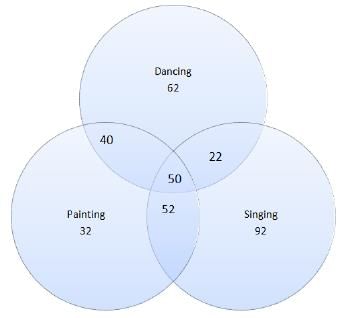PPSC Prelims Paper 2 Mock Test - 2 - PPSC PCS (Punjab) MCQ
30 Questions MCQ Test - PPSC Prelims Paper 2 Mock Test - 2
The Christmas season, of course, is an appropriate time of year to reflect on busyness. The time between Christmas and New Year should be a time for reflection and relaxation, but is often stressed. Rather than taking time out after the busyness of Christmas preparations, many of us find ourselves in a whirlwind of sales shopping, sporting activities, or visiting friends or family. One form of busyness is replaced by another. Being busy has become so ubiquitous it has come to mean everything and nothing. As more people identify with the problem of busyness, some of us seek advice from time management experts about how to manage our busy lives. But data suggests that we are not as busy as we think we are. Social scientists who, specialise in researching every day time- use can compare trends in how we spend time from the 1960s onwards. The UK expert on time use, Jonathan Gershuny, claims that actual time spent in work has not increased since the 1960s - but what we mean by busyness has changed over time. In his view, busyness has become a badge of honour. There are a number of reasons for this change in definition. More women in the workforce mean that more households have to juggle both partners working with the demands of domestic routines. Meanwhile, social prestige is associated with being busy and, as we often experience at Christmas, leisure time has become more of an intensive experience.
According to author visiting friends, shopping etc while Christmas is?
The Christmas season, of course, is an appropriate time of year to reflect on busyness. The time between Christmas and New Year should be a time for reflection and relaxation, but is often stressed. Rather than taking time out after the busyness of Christmas preparations, many of us find ourselves in a whirlwind of sales shopping, sporting activities, or visiting friends or family. One form of busyness is replaced by another. Being busy has become so ubiquitous it has come to mean everything and nothing. As more people identify with the problem of busyness, some of us seek advice from time management experts about how to manage our busy lives. But data suggests that we are not as busy as we think we are. Social scientists who, specialise in researching every day time- use can compare trends in how we spend time from the 1960s onwards. The UK expert on time use, Jonathan Gershuny, claims that actual time spent in work has not increased since the 1960s - but what we mean by busyness has changed over time. In his view, busyness has become a badge of honour. There are a number of reasons for this change in definition. More women in the workforce mean that more households have to juggle both partners working with the demands of domestic routines. Meanwhile, social prestige is associated with being busy and, as we often experience at Christmas, leisure time has become more of an intensive experience.
What is/are the view(s) of time management experts?
1. During Christmas avoid shopping, visiting friends.
2. Now busyness has become a badge of honour.
We are not as busy as we think.
1. During Christmas avoid shopping, visiting friends.
2. Now busyness has become a badge of honour.
We are not as busy as we think.
The Christmas season, of course, is an appropriate time of year to reflect on busyness. The time between Christmas and New Year should be a time for reflection and relaxation, but is often stressed. Rather than taking time out after the busyness of Christmas preparations, many of us find ourselves in a whirlwind of sales shopping, sporting activities, or visiting friends or family. One form of busyness is replaced by another. Being busy has become so ubiquitous it has come to mean everything and nothing. As more people identify with the problem of busyness, some of us seek advice from time management experts about how to manage our busy lives. But data suggests that we are not as busy as we think we are. Social scientists who, specialise in researching every day time- use can compare trends in how we spend time from the 1960s onwards. The UK expert on time use, Jonathan Gershuny, claims that actual time spent in work has not increased since the 1960s - but what we mean by busyness has changed over time. In his view, busyness has become a badge of honour. There are a number of reasons for this change in definition. More women in the workforce mean that more households have to juggle both partners working with the demands of domestic routines. Meanwhile, social prestige is associated with being busy and, as we often experience at Christmas, leisure time has become more of an intensive experience.
What is/are the reason(s) for the change in the definition of busyness?
1. Social prestige is associated with being busy.
2. More women in the workforce
Just as one must learn the art of killing in the training for violence, so one must learn the art of dying in the training for non-violence. Violence does not mean emancipation from fear, but discovering the means of combating the cause of fear. Non-violence, on the other hand, has no cause for fear. The votary of non-violence has to cultivate the capacity for sacrifice of the highest type in order to be free from fear. He recks not if he should lose his hand, his wealth, his life. He who has not overcome all fear cannot practice ahimsa to perfection. The votary of ahimsa has only one fear that is of god. He who seeks refuge in god ought to have a glimpse of the atma that transcends the body; and the moment one has a glimpse of the imperishable Atma one sheds the love of the perishable body. Training in violence is thus diametrically opposed to training in violence. Violence is needed for the protection of things external; non-violence is needed for the protection of Atma, for the protection of one’s honour.
Which of the following statement as per the passage are correct?
1. Violence means overcoming the cause of fear.
2. Violence means trying to eliminate the cause of fear.
3. Non-violence means combating the source of fear.
4. Non-violence means sacrificing even self for shedding fear.
Just as one must learn the art of killing in the training for violence, so one must learn the art of dying in the training for non-violence. Violence does not mean emancipation from fear, but discovering the means of combating the cause of fear. Non-violence, on the other hand, has no cause for fear. The votary of non-violence has to cultivate the capacity for sacrifice of the highest type in order to be free from fear. He recks not if he should lose his hand, his wealth, his life. He who has not overcome all fear cannot practice ahimsa to perfection. The votary of ahimsa has only one fear that is of god. He who seeks refuge in god ought to have a glimpse of the atma that transcends the body; and the moment one has a glimpse of the imperishable Atma one sheds the love of the perishable body. Training in violence is thus diametrically opposed to training in violence. Violence is needed for the protection of things external; non-violence is needed for the protection of Atma, for the protection of one’s honour.
Why does the author suggest that practitioners of non-violence should develop capacity for sacrifice?
If x $ y = (x + y + xy -1) (x + y + xy + , then the value of (4 $ 5) is.
Each of the 350 members in a society is required to sign up for a minimum of one and a maximum of three clubs. The three clubs to choose from are the painting club, the singing club, and the dancing club. A total of 174 peoples sign up for the dancing club, 126 students for the singing club, and 174 students for the painting club. If 114 students sign up for exactly two clubs, how many students sign up for all three clubs?
The diagonal of a rectangle is V21 cm and its area is 50 sq. cm. What is the perimeter of the rectangle?
Although pathogenic organisms constantly alight on the skin, they find it a very unfavourable environment and, in the absence of injury, have great difficulty colonizing it. This "self-sterilizing" capacity of the skin results from the tendency of all well-developed ecosystems toward homeostasis, or the maintenance of the status quo. Species that typically live in
soil, water, and elsewhere rarely multiply on the skin. Undamaged skin is also unfavourable to most human pathogens. The skin is too acid and too arid for some species. The constant shedding of the surface skin layers further hinders the establishment of invaders. The most interesting defence mechanism, however, results from the metabolic activities of the resident flora. Unsaturated fatty acids, an important component of the lipids in sebum collected from the skin surface, inhibit the growth of several bacterial and fungal cutaneous pathogens. These acids are a metabolic product of certain gram-positive members of the cutaneous community, which break down the more complex lipids in freshly secreted sebum.
Q. The primary purpose of the passage is to
Although pathogenic organisms constantly alight on the skin, they find it a very unfavourable environment and, in the absence of injury, have great difficulty colonizing it. This "self-sterilizing" capacity of the skin results from the tendency of all well-developed ecosystems toward homeostasis, or the maintenance of the status quo. Species that typically live in
soil, water, and elsewhere rarely multiply on the skin. Undamaged skin is also unfavourable to most human pathogens. The skin is too acid and too arid for some species. The constant shedding of the surface skin layers further hinders the establishment of invaders. The most interesting defence mechanism, however, results from the metabolic activities of the resident flora. Unsaturated fatty acids, an important component of the lipids in sebum collected from the skin surface, inhibit the growth of several bacterial and fungal cutaneous pathogens. These acids are a metabolic product of certain gram-positive members of the cutaneous community, which break down the more complex lipids in freshly secreted sebum.
Q. The "resident flora” mentioned refer to
Correct the given equations by interchanging the two signs (10 - 14 ÷ 7 x 3 + 4 = 20)
Directions: Read the following information carefully and answer the questions that follow—
Five plays A, B, C, D and E are to be staged from Monday to Friday of a week. On each day, only one play will be staged. D or E should not be either the first or last to be staged. E should be immediately followed by C. B should be staged immediately after D. One play is staged between A and B.
Q. Which is the first play to be staged?
Directions: Read the following information carefully and answer the questions that follow—
Five plays A, B, C, D and E are to be staged from Monday to Friday of a week. On each day, only one play will be staged. D or E should not be either the first or last to be staged. E should be immediately followed by C. B should be staged immediately after D. One play is staged between A and B.
Q. Which of the following is the correct sequence of staging all the plays?
Directions: Read the following information carefully and answer the questions that follow—
Five plays A, B, C, D and E are to be staged from Monday to Friday of a week. On each day, only one play will be staged. D or E should not be either the first or last to be staged. E should be immediately followed by C. B should be staged immediately after D. One play is staged between A and B.
Q. Which play was staged on Wednesday?
Consider two alloys A and B. 70 kg of alloy A is mixed with 90 kg of alloy B. A contains Aluminium and Gold in the ratio 3: 4, and B contains them in the ratio 4: 5 respectively. What is the ratio of Gold to Aluminium in the mixture?
A Salesman charges sales tax of x% upto Rs. 4,000 and above it he charges y%.
A customer pays total tax of Rs 400, when he purchases the goods worth Rs. 6,000 and he pay’s the total tax of Rs. 2200 for the goods worth Rs. 24,000. The value of x and y is:
India is rushing headlong towards economic success and modernisation, counting on high- tech industries such as information technology and biotechnology to propel the nation to prosperity. India’s recent announcement that it would no longer produce unlicensed inexpensive generic pharmaceuticals bowed to the realities of the World Trade Organisation while at the same time challenging the domestic drug industry to compete with the multinational firms. Unfortunately, its weak higher education sector constitutes the Achilles heel of this strategy. India’s main competitors especially China but also Singapore, Taiwan, and South Korea are investing in large and differentiated higher education systems. They are providing access to large numbers of students at the bottom of the academic system while at the same time building some research based universities that are able to compete with the world’s best institutions. There are a small number of high quality institutions, departments, and centres that can form the basis of the quality sector in higher education. India Educates approximately 10 percent of Its young people in higher education compared with more than half in the major industrialized countries and 15 percent in China. Almost all of the world’s academic systems resemble a pyramid, with a small high quality tier at the top and massive sector at the bottom. India has a tiny top tier. None of its universities occupies a solid position at the top. A few of the best universities have some excellent departments and centres, and there are a small number of outstanding undergraduate colleges.
Q. By what measures can you say that the Asian countries, other than India, are heading towards a knowledge based economy?
1. Building competitive research based universities.
2. Investing in diverse higher education systems,
3. Providing access to higher education to a select few students.
India is rushing headlong towards economic success and modernisation, counting on high- tech industries such as information technology and biotechnology to propel the nation to prosperity. India’s recent announcement that it would no longer produce unlicensed inexpensive generic pharmaceuticals bowed to the realities of the World Trade Organisation while at the same time challenging the domestic drug industry to compete with the multinational firms. Unfortunately, its weak higher education sector constitutes the Achilles heel of this strategy. India’s main competitors especially China but also Singapore, Taiwan, and South Korea are investing in large and differentiated higher education systems. They are providing access to large numbers of students at the bottom of the academic system while at the same time building some research based universities that are able to compete with the world’s best institutions. There are a small number of high quality institutions, departments, and centres that can form the basis of the quality sector in higher education. India Educates approximately 10 percent of Its young people in higher education compared with more than half in the major industrialized countries and 15 percent in China. Almost all of the world’s academic systems resemble a pyramid, with a small high quality tier at the top and massive sector at the bottom. India has a tiny top tier. None of its universities occupies a solid position at the top. A few of the best universities have some excellent departments and centres, and there are a small number of outstanding undergraduate colleges.
What did India agree to do at the behest of the World Trade Organisation?
India is rushing headlong towards economic success and modernisation, counting on high- tech industries such as information technology and biotechnology to propel the nation to prosperity. India’s recent announcement that it would no longer produce unlicensed inexpensive generic pharmaceuticals bowed to the realities of the World Trade Organisation while at the same time challenging the domestic drug industry to compete with the multinational firms. Unfortunately, its weak higher education sector constitutes the Achilles heel of this strategy. India’s main competitors especially China but also Singapore, Taiwan, and South Korea are investing in large and differentiated higher education systems. They are providing access to large numbers of students at the bottom of the academic system while at the same time building some research based universities that are able to compete with the world’s best institutions. There are a small number of high quality institutions, departments, and centres that can form the basis of the quality sector in higher education. India Educates approximately 10 percent of Its young people in higher education compared with more than half in the major industrialized countries and 15 percent in China. Almost all of the world’s academic systems resemble a pyramid, with a small high quality tier at the top and massive sector at the bottom. India has a tiny top tier. None of its universities occupies a solid position at the top. A few of the best universities have some excellent departments and centres, and there are a small number of outstanding undergraduate colleges.
Which of the following are India’s weaknesses when it comes to higher education?
1. Indian universities do not have the requisite teaching faculty to cater to the needs of the higher education sector.
2. Only five Indian universities occupy the top position very strongly, in the academic pyramid, when it comes to higher education.
3. India has the least percentage of young population taking to higher education as compared to the rest of the comparable countries.
Directions: Refer to the table below and answer the questions that follow. Salary range for an organisation for all male and female employees
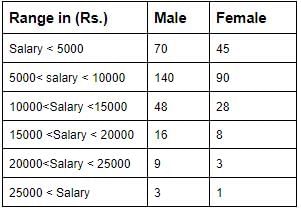
What is the approximate average monthly income of males in the organisation?
Directions: Refer to the table below and answer the questions that follow. Salary range for an organisation for all male and female employees
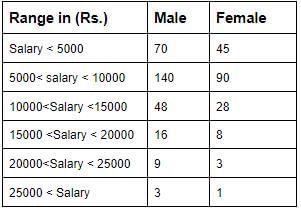
What is the minimum average monthly income (approximately) of the female employees who do not earn less than Rs 5000?
Directions: Refer to the table below and answer the questions that follow. Salary range for an organisation for all male and female employees
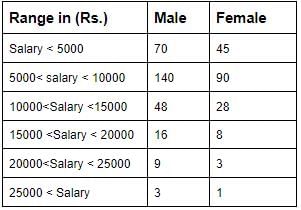
What is the ratio of the maximum average monthly salaries of all the male employees to all the female employees who earn equal?
Directions: Refer to the table below and answer the questions that follow. Salary range for an organisation for all male and female employees
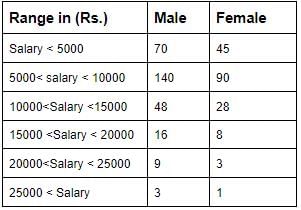
What percent of the total employees earn less than Rs 20000 but more than or equal to Rs 10000 as their monthly salary?
Directions: Refer to the table below and answer the questions that follow. Salary range for an organisation for all male and female employees
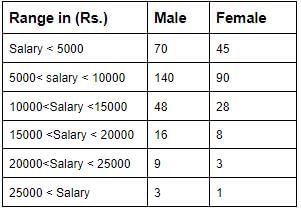
Which of the following cannot be deduced from the given data?
Passage 2
Newton's surprising success at developing the laws of motion, as well as the development and refinement of other physical laws, led to the idea of scientific determinism. The first expression of this principle was in the beginning of the nineteenth century by Laplace, a French scientist. Laplace argued that if one knew the position and velocity of all the particles in the universe at a given time, the laws of physics would be able to predict the future state of the universe.
Scientific determinism held sway over a great many scientists until the early twentieth century, when the quantum mechanics revolution occurred. Quantum mechanics introduced the world to the idea of the uncertainty principle, which stated that it was impossible to accurately measure both the position and the velocity of a particle at one time. Because Laplace's omniscience could never occur, even in theory, the principle of scientific determinism was thrown into doubt. However, quantum mechanics does allow for a reduced form of scientific determinism. Even though physicists are unable to know precisely where a particle is and what its velocity is, they can determine certain probabilities about its position and velocity. These probabilities are called wave functions. By use of a formula known as the Schrodinger equation, a scientist with the wave function of a particle at a given time can calculate the particle's future wave function. These calculations can give the particle's position or velocity, but not both. Thus, the physicist is in possession of exactly half of the information needed to satisfy Laplace's view of determinism. Unfortunately, under modern physics theories, that is far as any researcher can go in predicting the future.
Q. The passage suggests that if scientific determinism were TRUE:
Passage 2
Newton's surprising success at developing the laws of motion, as well as the development and refinement of other physical laws, led to the idea of scientific determinism. The first expression of this principle was in the beginning of the nineteenth century by Laplace, a French scientist. Laplace argued that if one knew the position and velocity of all the particles in the universe at a given time, the laws of physics would be able to predict the future state of the universe.
Scientific determinism held sway over a great many scientists until the early twentieth century, when the quantum mechanics revolution occurred. Quantum mechanics introduced the world to the idea of the uncertainty principle, which stated that it was impossible to accurately measure both the position and the velocity of a particle at one time. Because Laplace's omniscience could never occur, even in theory, the principle of scientific determinism was thrown into doubt. However, quantum mechanics does allow for a reduced form of scientific determinism. Even though physicists are unable to know precisely where a particle is and what its velocity is, they can determine certain probabilities about its position and velocity. These probabilities are called wave functions. By use of a formula known as the Schrodinger equation, a scientist with the wave function of a particle at a given time can calculate the particle's future wave function. These calculations can give the particle's position or velocity, but not both. Thus, the physicist is in possession of exactly half of the information needed to satisfy Laplace's view of determinism. Unfortunately, under modern physics theories, that is far as any researcher can go in predicting the future
Q. According to the passage, wave functions:
Passage 2
Newton's surprising success at developing the laws of motion, as well as the development and refinement of other physical laws, led to the idea of scientific determinism. The first expression of this principle was in the beginning of the nineteenth century by Laplace, a French scientist. Laplace argued that if one knew the position and velocity of all the particles in the universe at a given time, the laws of physics would be able to predict the future state ofthe universe.
Scientific determinism held sway over a great many scientists until the early twentieth century, when the quantum mechanics revolution occurred. Quantum mechanics introduced the world to the idea of the uncertainty principle, which stated that it was impossible to accurately measure both the position and the velocity of a particle at one time. Because Laplace's omniscience could never occur, even in theory, the principle of scientific determinism was thrown into doubt. However, quantum mechanics does allow for a reduced form of scientific determinism. Even though physicists are unable to know precisely where a particle is and what its velocity is, they can determine certain probabilities about its position and velocity. These probabilities are called wave functions. By use of a formula known as the Schrodinger equation, a scientist with the wave function of a particle at a given time can calculate the particle's future wave function. These calculations can give the particle's position or velocity, but not both. Thus, the physicist is in possession of exactly half ofthe information needed to satisfy Laplace's view ofdeterminism. Unfortunately, under modern physics theories, that is far as any researcher can go in predicting the future.
Q. Which of the following best describes the organization of the passage?
Passage 2
Newton's surprising success at developing the laws of motion, as well as the development and refinement of other physical laws, led to the idea of scientific determinism. The first expression of this principle was in the beginning of the nineteenth century by Laplace, a French scientist. Laplace argued that if one knew the position and velocity of all the particles in the universe at a given time, the laws of physics would be able to predict the future state of the universe.
Scientific determinism held sway over a great many scientists until the early twentieth century, when the quantum mechanics revolution occurred. Quantum mechanics introduced the world to the idea of the uncertainty principle, which stated that it was impossible to accurately measure both the position and the velocity of a particle at one time. Because Laplace's omniscience could never occur, even in theory, the principle of scientific determinism was thrown into doubt. However, quantum mechanics does allow for a reduced form of scientific determinism. Even though physicists are unable to know precisely where a particle is and what its velocity is, they can determine certain probabilities about its position and velocity. These probabilities are called wave functions. By use of a formula known as the Schrodinger equation, a scientist with the wave function of a particle at a given time can calculate the particle's future wave function. These calculations can give the particle's position or velocity, but not both. Thus, the physicist is in possession of exactly half of the information needed to satisfy Laplace's view of determinism. Unfortunately, under modern physics theories, that is far as any researcher can go in predicting the future
Q. Which of the following, if true, would most strengthen the author's conclusion in the passage's final sentence?
Directions for the following 8 (eight) questions:
Read the following two passages and answer the items that follow each passage. Your answers to these items should be based on these passages only.
Passage 1
The classical realist theory of international relations has long dominated both academic institutions and the American government. Even at the birth of the nation, early political thinkers, such as Alexander Hamilton, promoted a realist view of international relations and sought to influence the actions of the government based on this perspective. While the classical realist school of international relations is not entirely homogeneous in nature, there are certain premises that all classical realists share.
The primary principle underlying classical realism is a concern with issues of war and peace. Specifically, classical realists ask, what are the causes of war and what are the conditions of peace? The members of the classical realist school mainly attribute war and conflict to what is termed the security dilemma. In the absence ofany prevailing global authority, each nation is required to address its own security needs. However, each nation's quest for security-through military buildups, alliances, or territorial defenses—necessarily unsettles other nations. These nations react to feelings of insecurity by engaging in their own aggressive actions, which leads other nations to react similarly, perpetuating the cycle.
It is important to note that for realists, unlike idealists or liberal internationalists, international conflict is a necessary consequence of the structural anarchy that nations find themselves in. Whereas other schools may see international conflict as the result of evil dictators, historical chance, flawed socio political systems, or ignorance of world affairs, classical realists see war as the logical result of a system that by its nature lacks a true central authority.
Hand in hand with this view of conflict as an inevitable condition of the global power structure is the realists' view ofthe nation as a unitary actor. Because classical realists see international relations as a continuing struggle for dominance, the nation can not be viewed as a collection of individuals with disparate wants, goals, and ideologies. The realist view requires the formulation of a national interest, which in its simplest terms refers to the nation's ability to survive, maintain its security, and achieve some level of power relative to its competitors.
Realism is not without its critics, many of whom challenge the premise that war is the natural condition of international relations or that there can be a truly national interest. However, the realist school of international relations continues to shape foreign policy because ofthe successes it has had in describing real world interactions between nations.
Q. It can be inferred from the passage that members ofthe classical realist school would be LEAST likely to support.
Passage 1
The classical realist theory of international relations has long dominated both academic institutions and the American government. Even at the birth of the nation, early political thinkers, such as Alexander Hamilton, promoted a realist view of international relations and sought to influence the actions of the government based on this perspective. While the classical realist school of international relations is not entirely homogeneous in nature, there are certain premises that all classical realists share.
The primary principle underlying classical realism is a concern with issues of war and peace. Specifically, classical realists ask, what are the causes of war and what are the conditions of peace? The members of the classical realist school mainly attribute war and conflict to what is termed the security dilemma. In the absence ofany prevailing global authority, each nation is required to address its own security needs. However, each nation's quest for security-through military buildups, alliances, or territorial defenses—necessarily unsettles other nations. These nations react to feelings of insecurity by engaging in their own aggressive actions, which leads other nations to react similarly, perpetuating the cycle.
It is important to note that for realists, unlike idealists or liberal internationalists, international conflict is a necessary consequence of the structural anarchy that nations find themselves in. Whereas other schools may see international conflict as the result of evil dictators, historical chance, flawed socio political systems, or ignorance of world affairs, classical realists see war as the logical result of a system that by its nature lacks a true central authority.
Hand in hand with this view of conflict as an inevitable condition of the global power structure is the realists' view ofthe nation as a unitary actor. Because classical realists see international relations as a continuing struggle for dominance, the nation can not be viewed as a collection of individuals with disparate wants, goals, and ideologies. The realist view requires the formulation of a national interest, which in its simplest terms refers to the nation's ability to survive, maintain its security, and achieve some level of power relative to its competitors.
Realism is not without its critics, many of whom challenge the premise that war is the natural condition of international relations or that there can be a truly national interest. However, the realist school of international relations continues to shape foreign policy because ofthe successes it has had in describing real world interactions between nations.
Q. Which of the following, if true, would best support the classical realist theory of international conflict as it is described in the passage?



